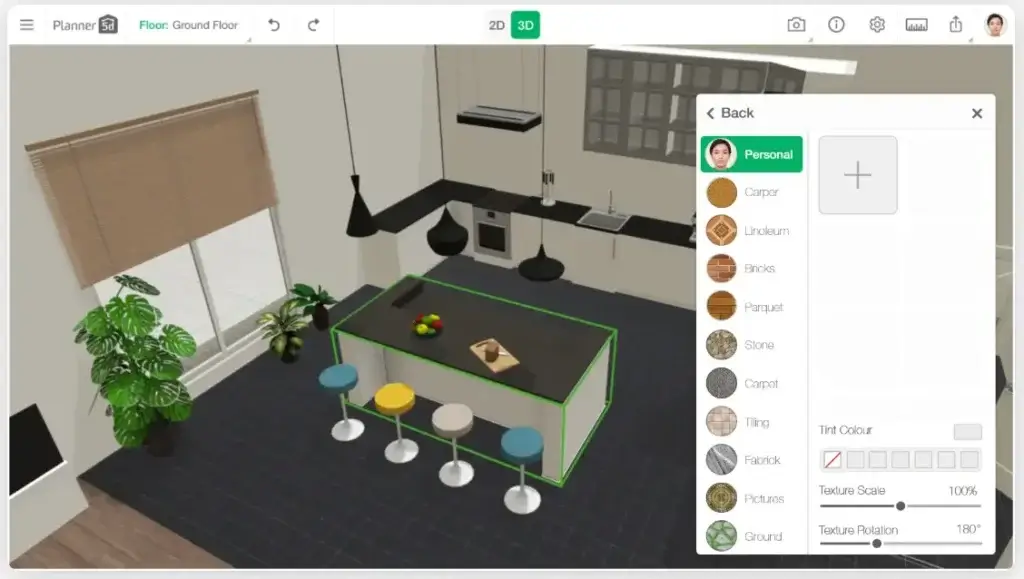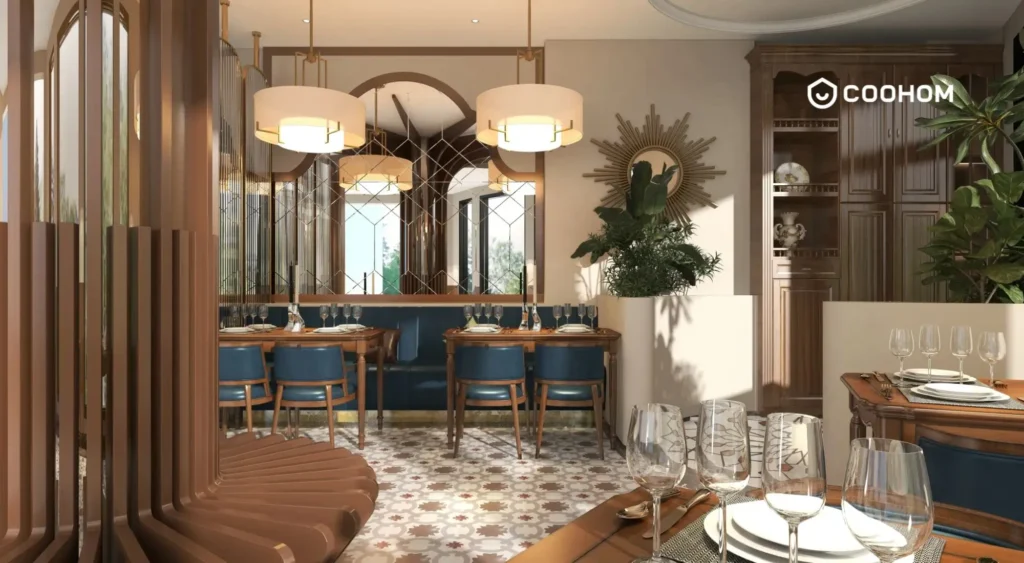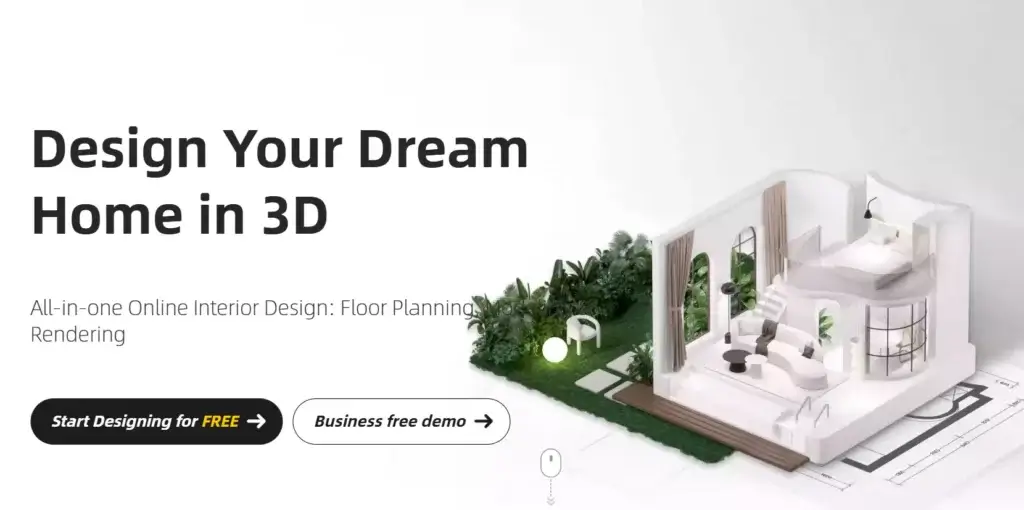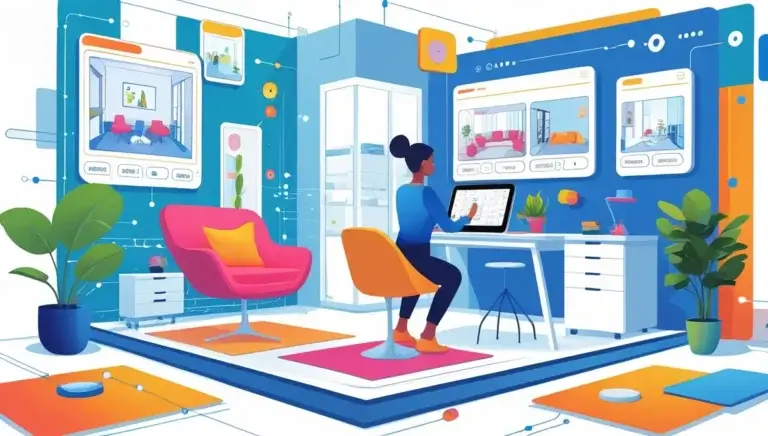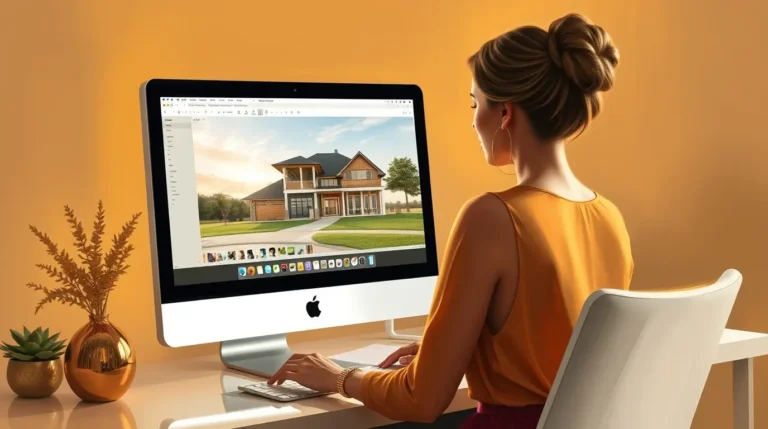Artificial intelligence is transforming interior design. It’s making the process smarter and more efficient.
AI interior design uses technology to create stunning, personalized spaces. Imagine having a virtual assistant that knows your style. AI can suggest furniture, colors, and layouts tailored to your taste. It can even predict trends and help you stay ahead.
This technology is not just for professionals; anyone can use it to design their dream home. AI tools are user-friendly and accessible, making interior design easier than ever. Dive into the world of AI interior design and see how it can change your home. Discover the future of creating beautiful, functional spaces with the help of AI.
AI In Design Tool
AI in interior design is transforming the way we visualize and create living spaces. Artificial Intelligence in Interior Design leverages advanced technologies to bring innovative solutions. AI tools assist designers in making more informed decisions, enhancing creativity, and improving efficiency. By integrating AI, interior designers can achieve more personalized and aesthetically pleasing outcomes.
Impact On Creativity
Artificial Intelligence in Interior Design significantly impacts creativity. Designers can now use Generative Design Algorithms to explore a vast array of design possibilities. These algorithms allow designers to create unique, customized designs that cater to individual preferences.
- Virtual Interior Design Tools enable designers to visualize spaces in 3D. This helps in experimenting with different layouts and styles before finalizing a design.
- Machine Learning For Design helps in analyzing trends and predicting future design preferences. This ensures that designs are not only current but also ahead of the curve.
- Smart Home Technology integration allows for the creation of modern, tech-savvy living spaces. This enhances the user experience and makes homes more functional.
Furthermore, AI offers Personalized Design Recommendations. By analyzing user data, AI can suggest design elements that match the user’s taste. This level of personalization was difficult to achieve before.
Below is a table illustrating how AI impacts different aspects of creativity in interior design:
| Aspect | AI Impact |
|---|---|
| Design Exploration | Generative Design Algorithms |
| Visualization | Virtual Interior Design Tools |
| Trend Analysis | Machine Learning For Design |
| Personalization | Personalized Design Recommendations |
Enhancing Efficiency
AI is not just about creativity; it also enhances efficiency in interior design. Automated Design Solutions streamline the design process, allowing designers to focus on more critical aspects. By automating repetitive tasks, AI saves time and reduces errors.
Here are some ways AI enhances efficiency:
- Interior Design Software equipped with AI features can quickly generate multiple design options. This speeds up the decision-making process.
- Data-Driven Design Decisions help in making more accurate and informed choices. AI can analyze vast amounts of data to identify the best materials, colors, and layouts.
- Virtual Interior Design Tools reduce the need for physical mock-ups. Designers can make changes in real-time, leading to faster project completion.
Using AI, designers can also improve the User Experience In Design. By understanding user behavior and preferences, AI can create more user-friendly spaces. This ensures that the final design is not only beautiful but also functional and comfortable.
Here’s a quick comparison of traditional design methods versus AI-enhanced methods:
| Traditional Methods | AI-Enhanced Methods |
|---|---|
| Manual Design Creation | Automated Design Solutions |
| Physical Mock-Ups | Virtual Interior Design Tools |
| Guesswork in Decisions | Data-Driven Design Decisions |
| General Recommendations | Personalized Design Recommendations |
Trends In Ai Interior Design

AI Interior Design is evolving at a rapid pace. New technologies are transforming how we decorate and design our living spaces. The latest trends in AI Interior Design bring innovation and creativity to the forefront. These trends include Virtual Reality Integration and Sustainable Solutions, which are reshaping the industry.
Virtual Reality Integration
Virtual Reality Integration is a significant trend in AI Interior Design. It allows designers and homeowners to visualize spaces before making any changes. 3D Visualization In Interior Design is a game-changer. It helps in creating accurate models of rooms and furniture placement.
Augmented Reality In Home Decor lets users see how different elements fit together. This technology overlays digital designs onto real-world spaces. It provides a realistic preview of the final result. Interior Design Software Tools that incorporate VR are becoming more popular.
- Enhanced visualization of design concepts
- Improved client-designer communication
- Reduced risk of costly mistakes
These tools offer Personalized Design Experiences. Users can customize colors, furniture, and layouts in real-time. Artificial Intelligence In Design assists in making these changes seamless. Machine Learning For Interior Design helps in predicting trends and suggesting design elements based on user preferences.
| Feature | Benefit |
|---|---|
| Real-time customization | Allows for immediate feedback and adjustments |
| Accurate 3D models | Provides a clear vision of the final design |
| Data-driven design trends | Helps in making informed design choices |
Sustainable Solutions
Sustainable Solutions are also trending in AI Interior Design. Eco-Friendly Interior Design focuses on using materials and practices that are better for the environment. This trend aims to reduce waste and energy consumption.
Smart Home Technology integrates with sustainable design. It includes automated lighting, heating, and cooling systems. These systems adjust based on the user’s habits, saving energy and resources. Automated Design Solutions help in creating efficient layouts that maximize natural light and ventilation.
Data-Driven Design Trends play a role in sustainability. They analyze patterns and suggest eco-friendly options. For example, choosing materials with lower carbon footprints. Machine Learning For Interior Design can predict the impact of different materials and designs on the environment.
- Use of renewable materials
- Energy-efficient home systems
- Reduction of waste and carbon footprint
Artificial Intelligence In Design supports sustainable practices. It provides insights into the most effective ways to use resources. 3D Visualization In Interior Design can simulate the environmental impact of different designs. This helps in making more informed decisions.
| Aspect | Impact |
|---|---|
| Renewable materials | Reduces dependency on non-renewable resources |
| Energy-efficient systems | Lowers energy consumption and costs |
| Waste reduction | Minimizes environmental impact |
Tools And Software
AI interior design has transformed the way we think about home decor. With advanced tools and software, creating beautiful spaces is now easier and more efficient. These technologies allow users to visualize, plan, and execute their design ideas with precision. From virtual interior design software to AI-driven home decor solutions, the possibilities are endless. In this section, we will explore some of the popular platforms and essential features to look for in AI interior design tools.
Popular Platforms
Several platforms offer advanced capabilities for AI interior design. These tools help users create stunning spaces with ease. Here are some of the most popular options:
- Planner 5D: This virtual interior design software allows users to create detailed 2D and 3D floor plans. It offers an extensive library of furniture and decor items to choose from.
- Coohom: Known for its user-friendly interface, this platform provides realistic 3D visualization tools. Users can design their rooms and see how different styles and layouts will look.
- Homestyler: An AI-driven home decor tool that offers features like automated home design and machine learning in interior design. It helps users get design style recommendations based on their preferences.
- Houzz Pro: This platform combines smart home design solutions with professional tools for designers. It offers project management, client collaboration, and 3D visualization tools.
- Modsy: Using AI design tools, Modsy provides users with personalized design plans. It offers realistic 3D renderings and design recommendations tailored to the user’s style.
These platforms make it easy for users to visualize and plan their spaces. They offer a range of features that cater to both beginners and professionals. Whether you want to create a simple room layout or a detailed home design, these tools have you covered.
Features To Look For
When choosing AI interior design tools, it’s important to consider the features they offer. Here are some key features to look for:
- 3D Visualization Tools: These tools allow users to see their designs in 3D. This helps in visualizing how the space will look with different furniture, colors, and decor items.
- Virtual Interior Design Software: Look for software that provides detailed 2D and 3D floor plans. This helps in planning the layout and ensuring that everything fits perfectly.
- Design Style Recommendations: AI-driven tools can suggest design styles based on user preferences. This feature helps in creating a cohesive and personalized look.
- Automated Home Design: Some tools offer automated design features. These features use machine learning to create optimized layouts and decor options.
- Smart Home Design Solutions: Look for tools that integrate with smart home devices. This allows for seamless control of lighting, temperature, and other smart home features.
- Artificial Intelligence Interior Design: AI can analyze user preferences and create customized design plans. This feature ensures that the designs are tailored to the user’s taste.
These features make AI interior design tools powerful and versatile. They help users create beautiful spaces with ease and precision. When selecting a tool, consider your needs and choose one that offers the features that will best help you achieve your design goals.
Credit: medium.com
User Experience
Artificial Intelligence in interior design is transforming how people create and experience their living spaces. User experience is at the core of this transformation, making the design process more intuitive, engaging, and tailored to individual needs. AI tools offer a range of features that enhance personalization and client interaction, ensuring a seamless and enjoyable journey from concept to completion.
Personalization Options
AI interior design offers extensive personalization options that cater to individual tastes and preferences. With interactive design tools, users can customize every detail of their space. These tools provide a user-friendly interface that simplifies the design process.
Here are some key features:
- Virtual Room Visualization: This feature allows users to see their design ideas come to life in a 3D space. It helps them make informed decisions about colors, furniture placement, and décor.
- Personalized Space Planning: AI algorithms analyze room dimensions and user preferences to suggest optimal layouts. This ensures that the space is both functional and aesthetically pleasing.
- Design Style Recommendations: Based on user inputs, AI can recommend design styles that match their tastes. Whether it’s modern, rustic, or eclectic, users receive curated suggestions that resonate with their vision.
- Ai-Driven Furniture Selection: AI can suggest furniture pieces that fit the room’s style and dimensions. This takes the guesswork out of shopping and ensures a cohesive design.
These personalization options make the design process more enjoyable and less stressful. Users can experiment with different styles and layouts without any commitment. This freedom to explore creates a more user-centric design experience.
Client Interaction
Effective client interaction is crucial in interior design. AI tools enhance communication between designers and clients, making the process more collaborative.
Consider these features:
| Feature | Benefit |
|---|---|
| 3D Modeling Software | Clients can visualize their space in three dimensions, making it easier to understand the design proposal. |
| Automated Design Solutions | AI generates design options based on client feedback, speeding up the decision-making process. |
| Smart Home Integration | Designs incorporate smart home technology, enhancing the functionality and convenience of the space. |
These features ensure that clients are involved in every step of the design process. Interactive design tools allow clients to make real-time changes to the design. This fosters a sense of ownership and satisfaction with the final result.
AI also facilitates better communication. Clients can provide feedback through the platform, and designers can respond promptly with updates. This continuous interaction ensures that the design evolves in line with the client’s vision.
Overall, AI enhances user experience by making interior design more personalized, interactive, and client-focused. It bridges the gap between concept and reality, creating spaces that truly reflect the user’s personality and lifestyle.
Challenges Faced
Artificial Intelligence (AI) is revolutionizing many fields, and interior design is no exception. AI interior design combines technology with creativity, offering Predictive Design Analytics, Ai-Driven Style Recommendations, and Virtual Interior Design. But, despite its many benefits, there are significant challenges. Let’s explore these challenges.
Data Privacy
AI interior design relies heavily on data. Designers use Machine Learning Design Tools and Algorithmic Space Planning to create Personalized Interior Aesthetics. This means collecting vast amounts of data about user preferences, habits, and even personal spaces. Data privacy becomes a significant concern.
Many users worry about how their data is collected, stored, and used. Sensitive information about their living spaces and preferences must be protected. Breaches in data privacy can lead to unauthorized access and misuse of personal information. Here are some data privacy challenges:
- Data Collection: Gathering user data without proper consent.
- Data Storage: Ensuring data is stored securely to prevent breaches.
- Data Usage: Making sure data is used ethically and as intended.
A table summarizing the data privacy challenges:
| Challenge | Description |
|---|---|
| Data Collection | Collecting user data with proper consent. |
| Data Storage | Storing data securely to avoid breaches. |
| Data Usage | Using data ethically and as intended. |
Ensuring data privacy involves using robust encryption methods, clear privacy policies, and gaining user trust through transparency. Without these measures, the success of AI-driven interior design could be at risk.
Quality Control
Another challenge in AI interior design is maintaining quality control. Smart Design Solutions and Automated Home Decor depend on algorithms and data. While this technology offers efficiency, it can sometimes lack the human touch. Here are some key quality control issues:
- Design Accuracy: AI predictions may not always match user expectations.
- Aesthetic Appeal: AI-driven designs may lack the personal touch of a human designer.
- User Experience: Ensuring the final design meets the user’s needs and preferences.
To address these issues, designers can combine AI with human expertise. A table highlighting the quality control measures:
| Issue | Solution |
|---|---|
| Design Accuracy | Regular updates and user feedback integration. |
| Aesthetic Appeal | Human oversight to add personal touches. |
| User Experience | User-centered design practices. |
Combining AI with human input can enhance the quality of designs. This hybrid approach leverages the strengths of technology and human creativity to produce superior results. User Experience In Design improves when designers ensure that AI designs are accurate, aesthetically pleasing, and user-focused.

Credit: www.youtube.com
Future Of Ai Design
Artificial Intelligence is transforming many industries, and interior design is no exception. The future of AI design promises to be innovative and impactful. AI Interior Design is about blending creativity with technology. It aims to make spaces more functional and aesthetically pleasing. With advancements in AI, the interior design process is becoming smarter, faster, and more efficient. Let’s explore the technologies and growth predictions shaping this exciting field.
Emerging Technologies
AI Interior Design leverages several emerging technologies to enhance creativity and efficiency. Generative Design Algorithms create multiple design options based on set parameters. This allows designers to choose the best one quickly.
Another technology making waves is Machine Learning Design Tools. These tools analyze user preferences and suggest design elements. They learn from past designs to improve future recommendations. This results in more personalized design recommendations.
3D Modeling Software is also crucial. It helps visualize spaces in three dimensions. Designers can see how different elements fit together. This reduces the risk of errors and saves time.
Smart Home Technology is becoming an integral part of interior design. It integrates devices and systems for a seamless living experience. Automated lighting, climate control, and security systems are examples. These technologies make homes more comfortable and energy-efficient.
Lastly, Augmented Reality In Interiors and Virtual Reality Home Design are gaining popularity. AR and VR allow clients to experience designs before they are implemented. They can walk through virtual spaces and make changes in real-time. This interactive experience enhances client satisfaction.
Below is a table summarizing these technologies:
| Technology | Description |
|---|---|
| Generative Design Algorithms | Create multiple design options based on parameters |
| Machine Learning Design Tools | Analyze preferences and suggest design elements |
| 3D Modeling Software | Visualize spaces in three dimensions |
| Smart Home Technology | Integrate devices for a seamless experience |
| Augmented Reality/Virtual Reality | Experience designs before implementation |
Predictions For Growth
The future of AI Interior Design is bright. Experts predict significant growth in this field. AI will become a standard tool for designers. It will streamline processes and improve accuracy. More designers will adopt Automated Interior Planning for efficient project management.
There will also be a rise in Sustainable Design Solutions. AI can analyze materials and energy use. This helps create eco-friendly designs. Clients are increasingly asking for sustainable options. AI can meet this demand effectively.
Personalized Design Recommendations will become more advanced. AI will understand client preferences better. This will lead to highly customized interiors. Clients will enjoy unique spaces tailored to their tastes.
AI is also expected to enhance collaboration. Designers can share ideas and work on projects together easily. AI tools will facilitate communication and coordination. This will lead to better outcomes and faster project completion.
Additionally, the integration of AI with Smart Home Technology will grow. Homes will become more intelligent and responsive. AI will manage various systems effortlessly. This will improve comfort and convenience for residents.
In summary, AI Interior Design is set to grow rapidly. The industry will see innovative tools and solutions. Designers will benefit from greater efficiency and creativity. Clients will enjoy more personalized and sustainable spaces.
5 Best Ai Apps For Interior Design In 2025
In 2025, AI interior design apps will transform the way we decorate our homes. These apps offer virtual interior design, interior visualization tools, and more. They bring ease and efficiency to home decoration. Here are the five best AI apps for interior design in 2025.
1. Planner 5D: House Design Software | Home Design In 3D
Planner 5D is a powerful tool for home design in 3D. It provides a user-friendly interface for creating detailed home layouts. Here are some key features:
- 3D Home Modeling: Visualize your design ideas in 3D.
- Extensive Catalog: Access a wide range of furniture and decor.
- Customization: Personalize every detail of your design.
- Easy to Use: No professional skills needed.
Planner 5D offers an intuitive way to plan and visualize home interiors. It’s ideal for anyone looking to create stunning home designs without the need for complex software.
Planner 5D official Website Click here
2. Coohom – Free 3d Home Design Software & Floor Planner Online
Coohom is a free, online floor planner and 3D home design software. It’s perfect for both professionals and hobbyists. Key features include:
- Online Floor Planner: Design layouts directly in your browser.
- Interior Visualization Tools: See your designs in realistic 3D.
- Drag-and-Drop Interface: Easy to use for quick designs.
- Vast Library: Thousands of furniture pieces and decor items.
Coohom simplifies the process of home design with its user-friendly platform and extensive resources, making it a go-to choice for digital interior planning.
Coohom official Website Click here
3. Homestyler-interior Home Design,house Floor Planner 3d Online
Homestyler is another excellent tool for interior home design and 3D floor planning. It offers:
- 3D Home Modeling: Create and view your designs in 3D.
- Space Planning Applications: Efficiently plan the use of space.
- Community Sharing: Share your designs with a community of users.
- Professional Templates: Use templates designed by professionals.
Homestyler combines ease of use with professional-grade features, making it an ideal choice for both novices and seasoned designers.
HomeStyler official Website Click here
4. AI HomeDesign: Ai Toolbox For Property Listing
AI HomeDesign is tailored for property listings, offering an AI-driven home design toolbox. Its highlights include:
- AI Architecture: Automate the design process with AI.
- Virtual Staging: Virtually stage homes for listings.
- Real-Time Collaboration: Work with others in real-time.
- Property Optimization: Enhance property appeal with AI suggestions.
AI HomeDesign is a game-changer for real estate professionals, making property listings more attractive and efficient to manage.
AI Home Design official Website Click here
5. Cedreo: Easy 3D Home Design Software (interior & Exterior)
Cedreo offers comprehensive 3D home design software for both interior and exterior projects. Key features include:
- Architectural Design Software: Professional-level design tools.
- Home Decoration Software: Decorate interiors with ease.
- Exterior Design Tools: Plan outdoor spaces as well.
- Fast Rendering: Quick and realistic rendering of designs.
Cedreo is perfect for creating detailed and realistic home designs, both inside and out, with professional-level precision and ease of use.
Cedreo official Website Click here

Credit: www.unite.ai
Case Studies
Artificial Intelligence Interior Design has revolutionized the way we conceptualize and create living spaces. Through various case studies, we can explore how AI-driven design solutions have been applied successfully, and the lessons learned from these innovative projects. These real-world examples illustrate the potential of AI in enhancing both aesthetic and functional aspects of interior design.
Successful Projects
AI-driven design solutions have led to many successful projects. Let’s explore some notable examples:
- Smart Home Design: A project in Tokyo utilized AI to design a smart home. The AI suggested layouts that optimized space and functionality. It predicted the family’s needs and adjusted the design accordingly. The result was a highly efficient living space.
- Virtual Staging Technology: A real estate company used virtual staging technology to showcase properties. AI created realistic interior visuals. This helped potential buyers visualize their future homes, leading to faster sales.
Another remarkable project involved generative design software. This software designed a modern office space in New York. It considered employee interactions, lighting, and comfort. The final design increased productivity and employee satisfaction.
| Project | Location | AI Technology Used |
|---|---|---|
| Smart Home Design | Tokyo | AI-driven layout optimization |
| Virtual Staging | Global | Virtual staging technology |
| Office Space Design | New York | Generative design software |
Lessons Learned
From these case studies, several important lessons have been learned:
- Personalized Interior Experiences: AI can create designs that cater to individual preferences. Understanding user needs is crucial for success.
- Trend Forecasting In Design: AI can predict future design trends. This helps in creating timeless and appealing designs.
Adapting to AI tools like design automation tools can be challenging. Training and familiarity with these tools are necessary. Projects that include machine learning in interior design show better results. Continuous learning and adaptation are key.
AI can also enhance architectural visualization. This allows clients to see realistic models of their designs. It helps in making informed decisions. Clear communication between designers and AI systems is essential. Misunderstandings can lead to design flaws.
Overall, AI has shown great potential in interior design. It offers both efficiency and creativity. By learning from these projects, designers can harness the full power of AI for future endeavors.
Frequently Asked Questions
What Is Ai Interior Design?
AI interior design uses artificial intelligence to create home decor and layouts. It suggests styles based on your preferences.
How Does Ai Help In Interior Design?
AI analyzes your style choices and room dimensions. Then it suggests furniture, colors, and layouts that fit your taste.
Can Ai Interior Design Save Time?
Yes, AI quickly provides design ideas. It helps you avoid long hours of planning and decision-making.
Is Ai Interior Design Expensive?
No, many AI design tools are affordable. Some even offer free trials or basic services.
Are Ai Interior Design Suggestions Accurate?
Yes, AI uses large data sets and advanced algorithms. It provides accurate and personalized design suggestions.
Conclusion
AI interior design offers endless possibilities for home transformations. It blends creativity with technology. This approach makes designing more accessible and fun. You can try new styles without the risk. It’s perfect for anyone wanting a fresh look. AI tools make the process smoother and faster.
Easy for beginners, helpful for experts. So, consider AI for your next project. Your dream space is just a few clicks away. Embrace the future of interior design today!

My name is Mahi Uddin, and I’m a blog writer with over two years of experience specializing in creating engaging, informative content using AI tools. I contribute to InExDecor.com, where I share creative ideas and practical tips for transforming interior and exterior spaces into beautiful, functional environments. With a passion for storytelling and a knack for blending creativity with technology, I strive to craft blogs that not only inform but also inspire readers. When I’m not writing, you can find me exploring design trends or enjoying a good book with a cup of coffee.


